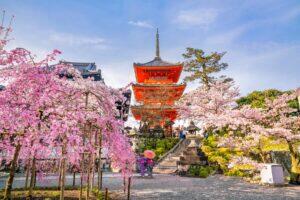Fodor's Expert Review Daitoku-ji Temple
This major temple complex of the Rinzai sect of Zen Buddhism dates from 1319, but fires during the Onin Civil War destroyed it in 1468. Most buildings now here were erected under the patronage of the warlord Toyotomi Hideyoshi in the late 16th century. The four subtemples below are open to visitors much of the year, and several others are open during the spring and autumn.
Daisen-in is best known for its Muromachi-era garden, attributed to Soko Kogaku (1465–1548). The rock-and-gravel garden depicts the flow of life in the movement of a river, swirling around rocks, over a waterfall, and finally into an ocean of nothingness.
Ryogen-in has five small gardens of gravel, stone, and moss. The Ah-Un garden includes a stone with ripples emanating from it, symbolizing the cycle of life, from the "ah" sound said at birth to the "un" said at death, encompassing all in between.
Koto-in is famous for its long, maple tree–lined... READ MORE
This major temple complex of the Rinzai sect of Zen Buddhism dates from 1319, but fires during the Onin Civil War destroyed it in 1468. Most buildings now here were erected under the patronage of the warlord Toyotomi Hideyoshi in the late 16th century. The four subtemples below are open to visitors much of the year, and several others are open during the spring and autumn.
Daisen-in is best known for its Muromachi-era garden, attributed to Soko Kogaku (1465–1548). The rock-and-gravel garden depicts the flow of life in the movement of a river, swirling around rocks, over a waterfall, and finally into an ocean of nothingness.
Ryogen-in has five small gardens of gravel, stone, and moss. The Ah-Un garden includes a stone with ripples emanating from it, symbolizing the cycle of life, from the "ah" sound said at birth to the "un" said at death, encompassing all in between.
Koto-in is famous for its long, maple tree–lined approach and the single stone lantern central to the main moss-carpeted garden.
Zuiho-in has Hidden Christian roots. Its rock garden suggests an abstract cross; a statue of Mary is supposedly buried under the stone lantern in an adjacent garden.
READ LESS







